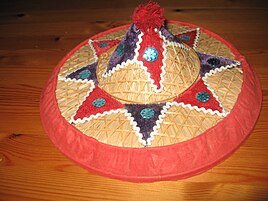Jaapi
 An Assamese Jaapi | |
| Related instruments | |
|---|---|
| Part of a series on the |
| Culture of Assam |
|---|
 |
Jaapi or Japi (Bodo: Khofri) is an Asian conical hat from Assam, India. It is made from tightly woven bamboo and/or cane and tokou paat (Trachycarpus martianus) a large, palm leaf. The word jaapi derives from jaap meaning a bundle of tokou leaves. In the past, plain jaapis were used by ordinary people in Assam and by farmers for protection from the sun, while ornate decorative jaapis were worn as a status symbol by the royalty and nobility. Decorative sorudoi jaapi are made with intricate cloth designs (primarily red, white, green, blue, and black) that are integrated into the weaving.
History
[edit]Originally a jaapi was an agricultural headgear used by farmers to protect themselves from the rain or the heat of the sun. The Bodo-Kacharis, the indigenous people of Assam, used plain japis while farming. Similar headgears were also used all throughout Southeast Asia and East Asia.[4] Bishnu Prasad Rabha innovated the japi dance to mainstream Assamese culture, through its use in Joymoti movie, from the Khofri Sibnai Mwsanai dance of the Bodo people.
The medieval Chutia kings used the jaapi as a cultural symbol. The last Chutia king gifted gold and silver embroidered Jaapis (Kup-ngiun-kham) to the Ahom king Suhungmung (1497–1539) as presents in his attempts for a treaty in the year 1523.[5][6] After annexing Sadiya in 1524, the Ahom king received a lot of treasure and bounty, which included Jaapis.[7] In the year 1525, the Ahom king gifted some of the silver Jaapis obtained from the Chutia king and other items, to negotiate peace with the Mongkawng chief Phukloimung, a Shan state in present Kachin State of Upper Myanmar (called Nora in Buranjis) who had attacked Sadiya.[8] During the Ahom rule, Jaapi-hajiya Khel (guild for making Jaapis) was monopolised by Chutias, which indicate that they were experts in weaving Jaapis.[9] Apart from this, the Baro-Bhuyans of Central Assam are also said to have used Jaapis. As per the Satsari Buranji, the Ahom kings adopted the Tongali, Hasoti and Tokou-patia Japi from the Baro-Bhuyans.[10]
-
Upper metal part of an ancient Varun (Tupi) Japi known as Sula used during the rule of Chutia kings kept in the Gharmora Satra.
-
Sarudaya jaapi
-
An ornately made jaapi
-
A jaapi at Kalakhetra, Guwahati
-
Jaapis made in Dhemaji
Cultural symbol
[edit]Today the jaapi is an important symbol of Assam and its culture. It is used during Bihu dance, as protection against the elements, offered as a sign of respect in ceremonies, and placed as a decorative item around the house especially in the walls as a welcome sign.[11][12]
Types
[edit]- Sorudoi japi: Used by women, especially brides.
- Bordoi japi: Used by royalty since ancient times (Kamrupa).
- Panidoi/Haluwa japi: Used by farmers in fields.
- Garakhiya japi: Used by cattle herders.
- Pitha japi: Used as hoods, sometimes during cultivation.
- Tupi/Varun japi: Used in rain as protective hats.
See also
[edit]References
[edit]- ^ "639 Identifier Documentation: aho – ISO 639-3". SIL International (formerly known as the Summer Institute of Linguistics). SIL International. Retrieved 29 June 2019.
Ahom [aho]
- ^ "Population by Religious Communities". Census India – 2001. Ministry of Home Affairs, Government of India. Retrieved 1 July 2019.
Census Data Finder/C Series/Population by Religious Communities
- ^ "Population by religion community – 2011". Census of India, 2011. The Registrar General & Census Commissioner, India. Archived from the original on 25 August 2015.
2011census/C-01/DDW00C-01 MDDS.XLS
- ^ শান্তনু কৌশিক বৰুৱা (2001). অসম অভিধান. বনলতা. pp. ১৪৪–১৪৬.
- ^ Khanikar 1991, p. 100.
- ^ ""Then the Chutiâ king desired to send silver and gold lipped Jâpi (Kup-ngiun-kham), gold bracelets (Mao-kham), gold basket (Liu-kham), gold ring (Khup-kham), gold bookstand (Khu-tin-kham), gold pirâ (Kham-ku), horse (Ma), elephant (Chang-pai), and two Âroans (Phra-nun) and Xorais (Phun) to the Ahom king."" (PDF). Archived from the original (PDF) on 28 July 2020. Retrieved 7 February 2020.
- ^ Mahanta 1945, p. 10.
- ^ Bhuyan 1960, p. 62.
- ^ "The Chutiyas were engaged in all kind of technical jobs of the Ahom kingdom. For example, the Khanikar Khel (guild of engineers) was always manneed by the Chutiyas. The Jaapi-Hajiya Khel (guild for making Jaapis) was also monopolished by them."(Dutta 1985:30)
- ^ Bhuyan 1960, p. 135.
- ^ Handoo 2003, p. 46.
- ^ Assam General Knowledge. Bright Publications. p. 98. ISBN 9788171994519.
External links
[edit]- Dutta, Sristidhar (1985), The Mataks and their Kingdom, Allahabad: Chugh Publications
- Khanikar, S (1991), Chutia Jaatir Itihax aru Luko-Sanskriti
- Bhuyan, Surjya K. (1960), Satsari Buranji
- Handoo, Jawaharlal (2003), Folklore in the Changing Times, Original from Indiana University: Indhira Gandhhi Rashtriya Manav Sangrahalaya
- Mahanta, S (1945), Assam Buranji.D.H.A.S.
- Some information about Assamese culture






